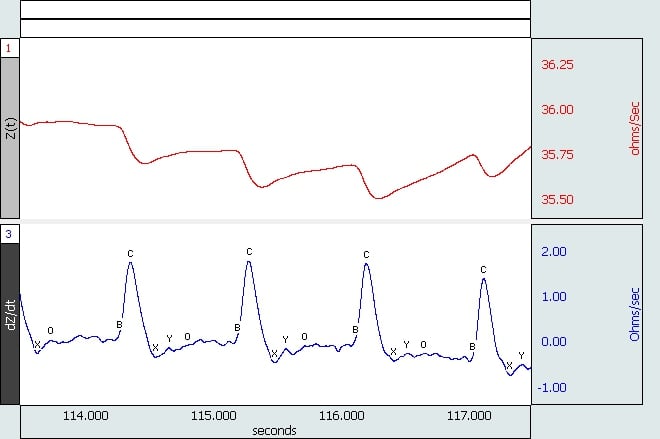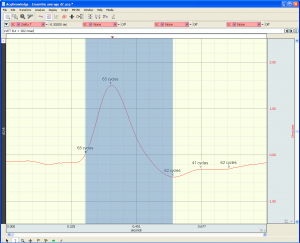ICG: Impedance Cardiography/Cardiac Output
Advanced Solutions for ICG Acquisition and Analysis
Wired, wireless, and MR solutions for measuring cardiac outupt
Comprehensive array of noninvasive impedance cardiography recording and measurement tools

Noninvasive impedance cardiography (ICG) tools
AcqKnowledge® offers a comprehensive array of noninvasive impedance cardiography (ICG) tools for recording parameters associated with virtually any kind of electrical bioimpedance (EBI) monitoring and bioimpedance analysis (BIA). Extracted measures can be displayed as new channels in the recording, or exported to an Excel spreadsheet or Journal file for further analysis. In addition to conventional BIOPAC® data acquisition hardware, record wirelessly with the BioNomadix® BN-NICO system.
Try ICG tools in the free AcqKnowledge Demo
See More...Hardware Packages | ICG: Impedance Cardiography/Cardiac Output
Hardware Bundles are complete solutions for the specified application. Choose your preferred platform and bundle, then click "Request Pricing" to request an estimate, add/remove items, or complete purchase. If you have questions about specific items, click through to the product web page for details and specifications, or contact your Local Sales contact.
Wired
-
Noninvasive BP Integrated System
Wired | ICG: Impedance Cardiography/Cardiac Output
NIBP100E noninvasive blood pressure system provides continuous, beat‐to‐beat, blood pressure signal and values (Sys, Dia, MAP) and Pulse Rate (PR). The system includes NIBP amplifier, double-finger cuffs, arm cuffs, CNAP Controller, and required hoses/cables. The system outputs a continuous blood pressure waveform that is similar to a direct arterial pressure waveform. The amplifier provides values for systolic, diastolic, mean blood pressure, and heart rate. The NIBP100E amplifier with CNAP™ technology is controlled by AcqKnowledge (v5.0.7) Research Software and connects to MP160 and MP150 data acquisition modules. To add hemodynamic parameters CO, CI, SV,SI, SVR, and SVRI, request NIBP100E-HD.
-
MP36R System plus NICO sensor & disposable electrodes
Wired | ICG: Impedance Cardiography/Cardiac Output
MP36R with AcqKnowledge plus NICO sensor, lead set, disposable strip electrodes, & disposable general purpose electrodes
-
MP160 System with NICO and ECG amplifiers and disposable electrodes
Wired | ICG: Impedance Cardiography/Cardiac Output
MP160 System with NICO and ECG amplifiers and disposable electrodes
-
MP160 System + ECG and EBI amps with disposable electrodes
Wired | ICG: Impedance Cardiography/Cardiac Output
MP160 with AcqKnowledge plus ECG & Electrical Bioimpedance Amps with disposable electrodes
Noninvasive BP Integrated System
- 1 x Noninvasive Blood Pressure Amplifier
MP36R System plus NICO sensor & disposable electrodes
- 1 x MP36R Systems
- 1 x Bioimpedance Strip Electrodes
- 1 x General-purpose Electrodes
- 1 x Electrode Gels
- 1 x Noninvasive Cardiac Output Sensor - MP3X
- 1 x Lead set, shielded, BSL
- 1 x Abrasive Pads 10/pk
MP160 System with NICO and ECG amplifiers and disposable electrodes
- 1 x MP160 Data Acquisition Systems
- 1 x Bioimpedance Strip Electrodes
- 1 x Module Extension Cables
- 1 x Lead Wires with Clip
- 1 x Lead Wires with Clip
- 1 x General-purpose Electrodes
- 1 x Electrode Gels
- 1 x Noninvasive Cardiac Output Module
- 1 x NICO100C/EBI100C Lead
- 1 x ECG Electrocardiogram Amplifier
- 1 x Abrasive Pads 10/pk
- 1 x Electrode Impedance Checker
MP160 System + ECG and EBI amps with disposable electrodes
- 1 x MP160 Data Acquisition Systems
- 1 x Bioimpedance Strip Electrodes
- 1 x Module Extension Cables
- 1 x Lead Wires with Clip
- 1 x Lead Wires with Clip
- 1 x General-purpose Electrodes
- 1 x Electrode Gels
- 1 x Electrobioimpedance Amplifier
- 1 x NICO100C/EBI100C Lead
- 1 x ECG Electrocardiogram Amplifier
- 1 x Abrasive Pads 10/pk
- 1 x Electrode Impedance Checker
Wireless
-
BioNomadix Logger with EMG Setup
Wireless | ICG: Impedance Cardiography/Cardiac Output
BioNomadix Logger and one transmitter for wireless EMG setup, plus leads and disposable electrodes
-
MP160 System plus wireless NICO and ECG with disposable electrodes
Wireless | ICG: Impedance Cardiography/Cardiac Output
MP160 with AcqKnowledge plus BioNomadix wireless NICO & ECG with disposable electrodes
BioNomadix Logger with EMG Setup
- 1 x BioNomadix Wireless Wearable Physiology Logger
- 1 x Electrode Leads - BioNomadix Wireless
- 1 x Electrode Leads - BioNomadix Wireless
- 1 x Cloth Base Electrodes
- 1 x Abrasive Pads 10/pk
- 1 x Electrode Impedance Checker
MP160 System plus wireless NICO and ECG with disposable electrodes
- 1 x MP160 Data Acquisition Systems
- 2 x Electrode Leads - BioNomadix Wireless
- 1 x Electrode Leads - BioNomadix Wireless
- 1 x Bioimpedance Strip Electrodes
- 1 x General-purpose Electrodes
- 1 x Electrode Gels
- 1 x BioNomadix Wireless Cardiac Output Amplifier
- 1 x BioNomadix 2Ch Wireless ECG Amplifier
- 1 x Abrasive Pads 10/pk
- 1 x Electrode Impedance Checker
MRI
-
MP160 System + NICO amp for MRI & disposable RT electrodes
MRI | ICG: Impedance Cardiography/Cardiac Output
MP160 System with NICO amplifier and disposable electrodes for MRI
MP160 System + NICO amp for MRI & disposable RT electrodes
- 1 x MP160 Data Acquisition Systems
- 1 x MRI Filtered Cable Sets
- 4 x Interface Cables CBL200 Series
- 8 x Leads - RT for MRI
- 1 x Noninvasive Cardiac Output Amplifier for MRI
- 8 x Disp. Radiotranslucent Electrode, 100/pk
- 1 x EEG/ECG/EMG/EOG Prep Gel 114 g
Animal
-
MP36R System plus NICO sensor & reusable electrodes
Animal | ICG: Impedance Cardiography/Cardiac Output
MP36R with AcqKnowledge plus NICO sensor, reusable 8 mm snap electrodes, & electrode lead adapter
-
MP160 System with NICO and ECG amps, needle electrodes + impedance checker
Animal | ICG: Impedance Cardiography/Cardiac Output
MP160 System with NICO and ECG amplifiers, needle electrodes & impedance checker
MP36R System plus NICO sensor & reusable electrodes
- 1 x MP36R Systems
- 6 x Ag-AgCl Reusable Snap Electrodes
- 1 x Adhesive Disks
- 1 x Noninvasive Cardiac Output Sensor - MP3X
- 1 x Tensive Adhesive Gel, 33 ml
- 1 x Electrode Lead Adapter, TP
- 1 x Abrasive Pads 10/pk
MP160 System with NICO and ECG amps, needle electrodes + impedance checker
- 1 x MP160 Data Acquisition Systems
- 4 x Interface Cables CBL200 Series
- 10 x Needle Electrodes - Animal/Tissue
- 1 x Module Extension Cables
- 1 x Noninvasive Cardiac Output Module
- 1 x ECG Electrocardiogram Amplifier
- 1 x Electrode Impedance Checker
Details
Impedance Cardiography Parameters
dZ-dt Classifier – AcqKnowledge® automatically scores the dZ/dt waveform with event markers indicating appropriate points in the complex to derive additional measures. For a detailed demo, see the ICG dZ-dt Classifier Tutorial Video.
ICG Analysis – Following dZ-dt scoring, apply the automated ICG analysis routine to derive a wide array of impedance and hemodynamic measures, such as pre-ejection period, stroke volume, cardiac output, heart rate, R-R interval, and more. Individual measures can be toggled on or off, allowing a customized subset of measurement data to be included in the output.
 Full list of measures extracted by ICG Analysis:
Full list of measures extracted by ICG Analysis:
Acceleration Index (AI) Cardiac Index (CI) Cardiac Output (CO) Heart Rate (HR) Left Cardiac Work (LCW) Left Cardiac Work Index (LCWI) Left Ventricular Ejection Time (LVET) Pre-ejection Period (PEP) RR Interval (RR) Stroke Index (SI) Stroke Volume (SV) Systemic Vascular Resistance (SVR) or Total Peripheral Resistance (TPR) Systemic Vascular Resistance Index (SVRI) Systolic Time Ratio (STR) Thoracic Fluid Content (TFC) Thoracic Fluid Index (TFI) Velocity Index (VI) Mean BP (requires additional signal) Mean CVP (requires additional signal) Mean PAP (requires additional signal)
Additional Impedance Cardiography tools for extracting advanced measures and cleaning data include:Videos
Support
Suggested Readings
- A novel noninvasive impedance-based technique for central venous pressure measurement
- Electrical Impedance Plethysmography; A Physical and Physiologic Approach to Peripheral Vascular Study. NYBOER J.
- Impedance Cardiography: Pulsatile blood flow and the biophysical electrodynamic basis for the stroke volume equations (new method comprises a three-compartment model)—Bernstein, Journal of Electrical Bioimpedance article
- Mathematical detection of aortic valve opening (B point) in impedance cardiography: A comparison of three popular algorithms—Psychophysiology article
- Methodological Guidelines for Impedance Cardiography, Sherwood et al, PSYCHOPHYSIOLOGY, Vol. 27, No. 1
- Quantifying rapid changes in cardiovascular state with a moving ensemble average, Cieslak M, Ryan WS, Babenko V, Erro H, Rathbun ZM, Meiring W, Kelsey RM, Blascovich J, Grafton ST. Psychophysiology. 2018 Apr;55(4). doi: 10.1111/psyp.13018. Epub 2017 Oct 3.
- Signal Fidelity Requirements for Deriving Impedance Cardiographic Measures
- ICG Applications
- BIOPAC ICG Product Citations: review publications summary or conduct a search
Application Notes
- 154 - High Level Transducer Connections - HLT100C
- 159 - Hand Switch and Foot Switch - TSD116 Series
- 109 - 3-, 6-, and 12-Lead ECG
- 110 - Amplifier Baseline Offset Adjustment
- 136 - Battery Pack Instructions - BAT100
- 185 - iMac and G3 Compatibility Issues
- 195 - MP System Data Sampling Reference
- 196 - Cardiac Output Measurement - EBI100C
- 207 - UDP Install: MP150 + No Network Access
- 208 - UDP Install: MP150 + Domain Network Access
- 209 - UDP Install: MP150 + Network Access or Multiple Computers
- 215 - Noninvasive Cardiac Ouput - NICO100C
- 115 - Hemodynamic Measurements
- 121 - Waveform Data Reduction
- 129 - Heart Rate Variability
- 142 - Rate Detector Algorithm in AcqKnowledge
- 143 - Importing AcqKnowledge Data Into Excel
- 148 - Automated ECG Analysis
- 155 - AcqKnowledge File Formats for the Macintosh
- 156 - AcqKnowledge File Formats for PC With Windows
- 177 - ECG Analysis Using the Offline Averaging Mode
- 191 - Digital I/O Channels
- 199 - Impedance Cardiography and Pre-ejection Period
- 204 - AcqKnowledge Peak Detector Operation
- 218 - Hardware API
- 219 - Known Issues - AcqKnowledge
- 116 - Hemodynamic Measurements - Part 2
- 001 - AcqKnowledge Release and OS Compatibility
- 267 - Wireless Noninvasive Cardiovascular Reactivity Measurement
- 294 - Trans-radial Electrical Bioimpedance Velocimetry (TREV and TRUEV)
Knowledge Base
- * CLEANING GUIDELINES *
- AC mode
- AcqKnowledge accuracy
- AcqKnowledge backwards compatibility
- Amplifier baseline offset adjustment
- Amplifier conversion - 2 mm to touchproof
- Amplifier filter settings
- Audio recording synchronization
- Band-pass and band-stop filters
- Bioimpedance Methods
- Biopotential amplifier signal validation
- Buffer overflow
- Calculating file sizes
- Combining Video with AcqKnowledge
- Common mistakes/general troubleshooting
- Connecting the TSD116C Switch Box
- Copy and paste append markers along with data
- Differences between the NICO100C and EBI100C
- Duplicating waveforms
- ECG Analysis
- ECG R-wave detector
- Editing noisy data
- Electrode Properties - gel and adhesive
- Electrode tape for cardiac output measurements
- Event Markers | Correcting Automated Placement
- Excel files exported from BIOPAC software open in Excel 'Protected View'
- Exporting Data to SPSS
- External Devices and Channel Contention
- Extracting data segments from a file
- Extracting heart rate from a noisy ECG signal
- Grounding guidelines
- Height/Weight entries for CO using Kubicek/Rho method
- High pass filters
- IIR vs. FIR filters
- Interfacing third-party transducers
- Inverted Waveform
- LabView interface
- Low pass filters
- Measuring respiration from impedance (ICG) data
- MP150 UDP protocol fixed IP address
- MRI - Triggering
- Multiple amplifiers per subject or multiple subjects per system
- NIBP100A single pulse data analysis
- Notch filter
- Optimal ground placement
- Outputting a signal through the STM100C
- Physiological measurements - life science signals using BIOPAC
- PPG setup and calibration
- Railing signal (flatline)
- Recording good data
- Text files - import and export
- Upgrading from PCMCIA to USB
- USB Drivers and Controller Communication
- Using other software with BIOPAC hardware
Stay Connected